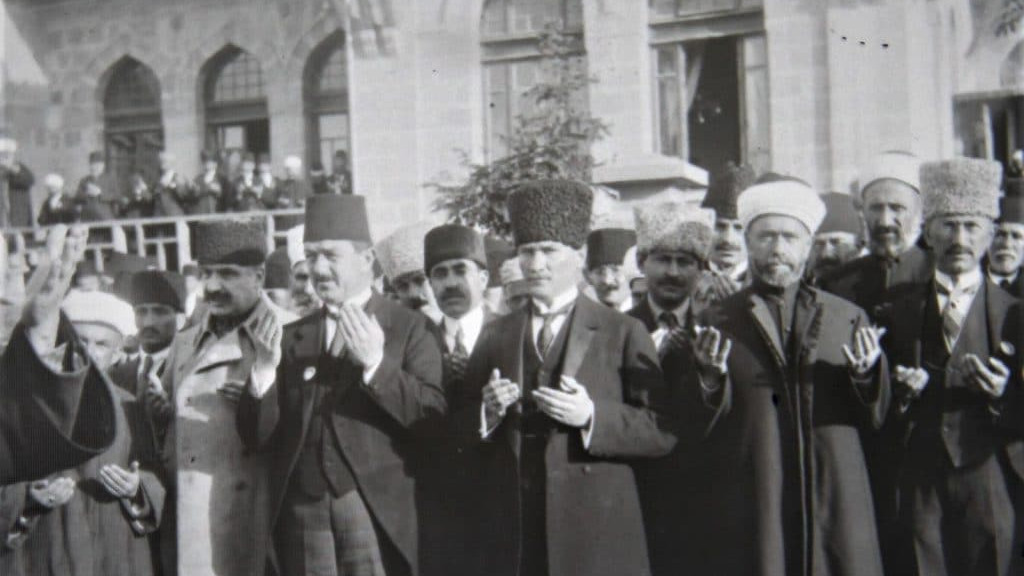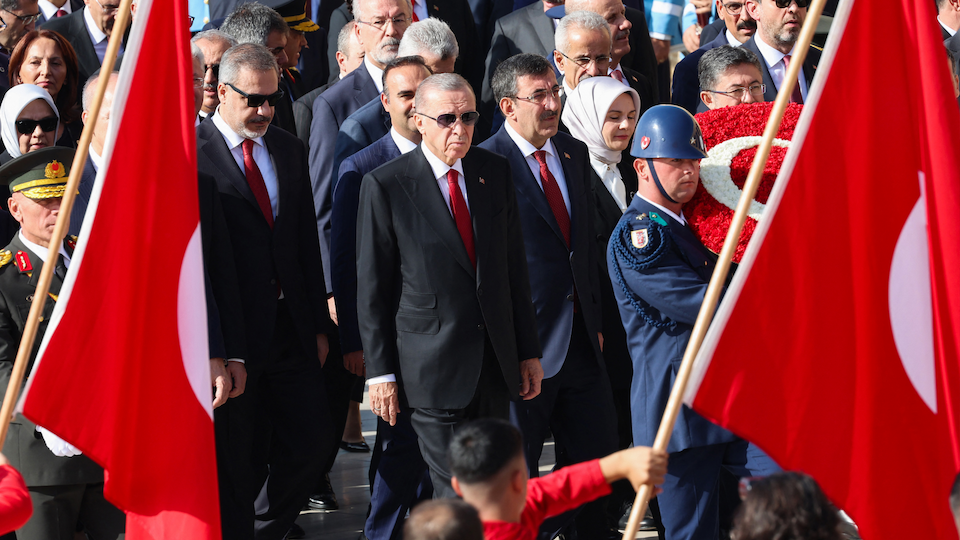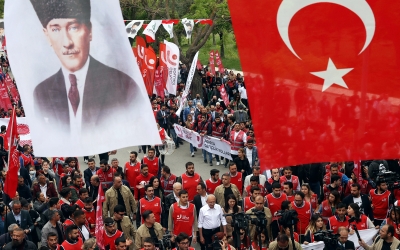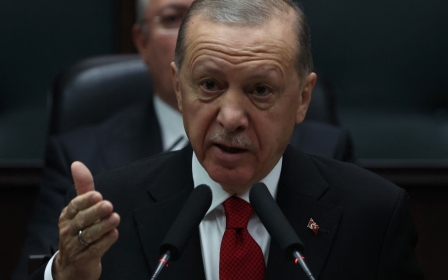Turkey at 100: How Erdogan made my family embrace Ataturk’s legacy
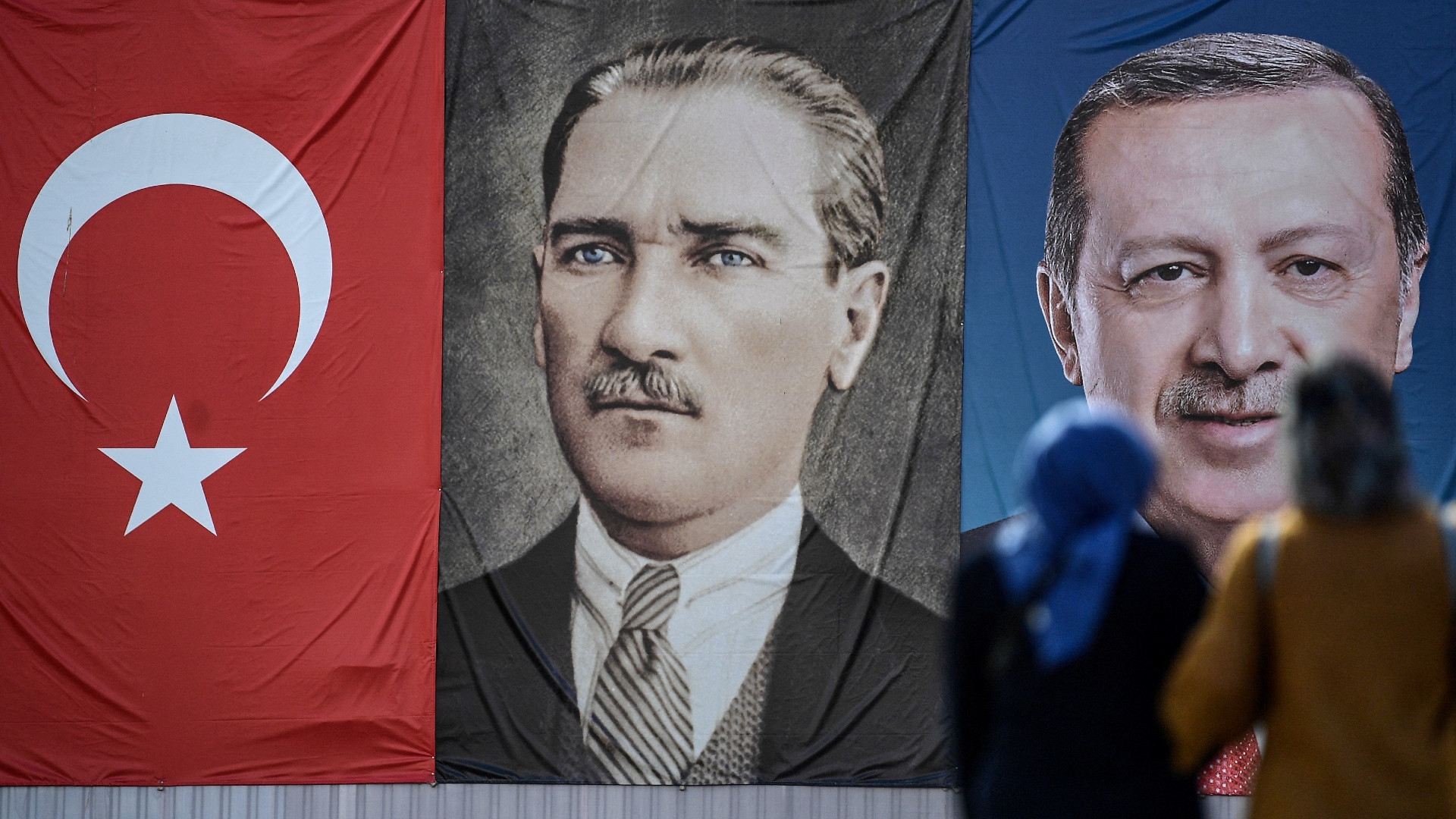
When I visited a small village along Turkey’s Black Sea coast with my mother a few years ago, I saw a large picture hanging from the entrance of a door where my grandmother used to reside.
It was a black and white photo that featured several men with serious and stern looks on their faces.
They could be seen raising their hands towards the sky in a sign of prayer.
In the background, there was a building with oriental features from a bygone area. To the right, far from the front, a man was sporting a white beard with a stern look on his face. He may have been bothered by the sun that was shining brightly on his face or was intensely focused on his supplication.
Whatever the reasons for his scowl, that man was my great-grandfather, Ahmet Kutri Efendi, an imam who led congregations at a mosque in Ankara’s Elmadag district.
Stay informed with MEE's newsletters
Sign up to get the latest alerts, insights and analysis, starting with Turkey Unpacked
And to the front, right in the centre, there was another man - a man whose portrait is virtually ubiquitous at every home, school and office across modern Turkey - Mustafa Kemal Pasha, also known as Ataturk, the father of Turks.
That photo was taken on the day the Turkish National Assembly opened in Ankara on 23 April 1920.
Previously, large parts of Turkey, formerly known as the Ottoman Empire, were occupied by the allied forces of Britain, France, Italy, and Greece, and the last Ottoman National Assembly had been rendered useless by a British raid in March of that year.
Mustafa Kemal and his associates were assembling another parliament in Ankara and my great-grandfather was among a group of revolutionaries who were trying to liberate the country between 1920 and 1922.
Ahmet Kutri Efendi helped the national resistance and took part in attempts to reclaim Turkish land, but still had a somewhat fraught relationship with the modern Republic of Turkey, which marked its 100th anniversary on 29 October.
Mixed emotions
Growing up, I was raised in a home where I was reminded of my family’s history, and as a result, politics was always at the forefront of the agenda.
Hearing stories from the past, there was a constant scuffle in my mind as to what the Turkish Republic was and what it actually stood for.
My parents, being devout and practising Muslims, had several issues with the state which, for them, was led by a secularist elite of bureaucrats and generals who claimed to preserve Ataturk’s legacy.
My father’s feelings towards the state were palpable. He was personally affected by the 1997 military intervention against Prime Minister Necmettin Erbakan’s Islamist government.
My grandmother from my father’s side would always use an angry tone when recalling Ataturk’s reforms on religion
I remember him being followed for months by the secret police and he spent a night at a police station on charges of “improperly accepting the donation of books on religion and theology”, of which he was later cleared.
This was a time when the headscarf, also known as the hijab, was banned at universities across the country. As a result, there were conflicting attitudes within my family towards Mustafa Kemal.
My grandmother from my father’s side would always use an angry tone when recalling Ataturk’s reforms on religion which mandated the Turkish recitation of the adhan (call to prayer) and Quran - typically recited in Arabic - in public, abolished the madrassah system, and placed restrictions on Sufism.
Ataturk’s changes to the dress code, which made it compulsory for men to wear hats instead of the Ottoman fez, were particularly noteworthy for my grandmother. A self-proclaimed preacher, she knew that in 1925 the government sent a navy ship to bombard villages near the Black Sea town of Rize to quell an insurrection against hats.
But my mother’s family was split on the legacy of Ahmet Kutri Efendi.
They would ask: "What must he have thought of Mustafa Kemal’s reforms, including his changes to religion, the stifling of dissent, and most importantly, the abolition of the caliphate?"
Conflicting narratives
For decades, one side would repeat over and over the same account of how Ahmet Kutri Efendi ran into trouble with Ataturk after the liberation of the country because he was an influential and pious member of a clergy that was still very traditional.
“He rallied support for the cause but once the war was over, he was a threat to Mustafa Kemal”, one distant uncle said. “They burned down his books and imprisoned him for several days. All his hair went white.”
Ahmet Kutri Efendi was later released and lived a quiet life, and years later died in Mecca during a pilgrimage there.
But other members of my family had a different account of the same history.
Another distant uncle, who is now a retired teacher, said it was all a misunderstanding. “He [Ahmet Kutri Efendi] was released once they understood that he was a member of Ataturk’s Republican People’s Party (CHP)”, he said, explaining that being a member of the secular CHP was proof of your loyalty to the government.
Ahmet Kutri Efendi, along with being a member of CHP, was also among the initial shareholders of Turkiye Isbank, the first national bank of Turkey, another sign that he supported some of the less controversial reforms Ataturk brought about.
Any time my mother’s family and her relatives met this uncle, named Ahmet, they would fight over politics.
He argued that Ahmet Kutri Efendi had a cordial relationship with Ataturk, one which also gave him the exceptional right to wear religious clothing at all times, while many were prosecuted for simply not wearing a hat.
He further shared that as a devout Muslim, he still voted for CHP and believed that his ancestor, Ahmet Kutri Efendi was also like him.
But my own family, who were unaffected by this story, continued to vote for politicians whom they believed stood against Turkish bureaucrats and a secular elite who guarded a regime that relegated religion to the private sphere.
For them, Mustafa Kemal saved the country with the help of political Islamists, Turkish nationalists and Kurds.
But he later purged them to carry out his secularist reforms.
The very photograph where Ahmet Kutri Efendi could be seen praying side by side with Mustafa Kemal was proof that Ataturk engaged with aspects of Islam before he adopted secularism for the state.
That’s why it was a popular picture used by religious conservatives - despite most practising Muslims shunning the display of photos in their homes.
Embracing Ataturk's legacy
My father’s mother entered local politics under Erbakan’s banner and continued to preach and urge constituents to vote for him.
After a military coup in 1980 saw Erbakan banned from politics, they voted for Turgut Ozal, the representative of neoliberal politics.
Each year, the debate around Ataturk’s reforms dissipated to the point where Erdogan and his party publicly and loudly commemorated him
They eventually switched to Recep Tayyip Erdogan, the mayor of Istanbul who fixed chronic infrastructure problems that had worsened in the city including water quality, waste management, and the cleaning of the Golden Horn, Istanbul's natural harbor.
My grandmother, an ardent supporter of Erbakan, also switched to Erdogan’s party in 2001, arguing that Erbakan was too old and wouldn't adapt to the times.
At the time, Erdogan was campaigning for many things most conservatives or Islamists would struggle to endorse.
He supported neoliberal and orthodox monetary policies and presented himself as a pro-EU politician who was open to talking with the US and Israel. He was against military tutelage and was comfortable with private universities opening up LGBT clubs.
So, why did many flock to his call?
One answer could be that Erdogan was sharply critical of Ataturk’s legacy. He never mentioned him by name but would repeatedly criticise the CHP’s one-party rule, the operation and handling of the Dersim rebellion, where thousands of Kurdish Alevites lost their lives, and other controversial steps he undertook in the 1920s and 30s.
But in recent years there has been a real shift in Turkey’s conservative politics.
As Erdogan aligned himself with Nationalist Movement Party (MHP) leader Devlet Bahceli, his party began to feel more comfortable with Ataturk.
Erdogan moved further into Turkish nationalist politics, using right-wing talking points that rallied many Turkish religious conservatives and nationalists. He created his favourite slogan and repeated it numerous times all over the country: “One homeland, one nation, one state, one flag.”
He said earlier this year that true nationalism could only be realised by making centuries-old dreams come true and establishing the Organisation of Turkic States, to ensure that Turkey could produce its own weapons, ships, warplanes, tanks, and cars.
He led the rapid development of the Turkish defence industry and carried out Turkish military operations against designated organisations in Syria and Iraq as a nationalist campaign to galvanise his base.
Each year, the debate around Ataturk’s reforms dissipated to the point where Erdogan and his party publicly and loudly commemorated the Turkish state and Ataturk’s contributions.
As religious conservatives succeeded in abolishing Ataturk's more draconian secularist policies, including the ban on hijab at public schools and religious education at a young age, the more they were willing to embrace him as a nationalist hero.
The same conservatives, including devout Islamists, who once viewed him as a saviour with several flaws, are now referring to him as a pioneering leader and liberator.
Erdogan's preferred honorific is “Gazi”, the religious term for a holy warrior, which was given to Ataturk by parliament in 1921 for winning the war against the invaders.
Despite some dissenting voices, Erdogan and his party seem to have made peace with Ataturk’s legacy. He is remembered as the country's founder, not in the same manner many devout Kemalists would like, but as a symbol of Turkish nationalism and modernism.
Ahead of this year’s presidential elections, which saw Erdogan cement his rule for another five years, the president ran a successful campaign where he pledged that under his watch Turkey would become a more powerful and prosperous nation whose reach extends beyond the region.
Such language, as Turkey embarked on its centenary, was also uttered by Ataturk 100 years ago.
In October, Erdogan visited Ataturk’s mausoleum, praising his achievements.
“Dear Ataturk, we are experiencing the pride and joy of reaching the 100th anniversary of the Republic of Turkey, which you call 'my greatest work' as a nation,” Erdogan wrote in the special memory book of the mausoleum.
“Our Republic is safer than ever before, in safe and competent hands. May your soul rest in peace. Happy 100th anniversary of our Republic.”
He then travelled to Istanbul, to attend the largest naval parade ever on the Bosporus.
Erdogan stayed at the Vahdettin Mansion, named after the last Ottoman sultan, who had to flee the country because Ataturk and his friends perceived him as a traitor and collaborator with the invaders, and saluted the navy.
He symbolically closed a chapter in which Turkish Islamists and secularists fought for decades, as he appeared to accept and acknowledge Ataturk but also embraced the Ottoman Empire’s last ruler.
As for my family, they still voted for Erdogan despite his open acknowledgement of Ataturk. They wouldn’t say it themselves, but they ironically now share the same nationalistic vision built by Ataturk 100 years ago. They are proud of the Turkish military’s success in the region, and national projects to produce cars, tanks, ships, and drones.
With Erdogan, now, they embrace Ataturk’s lasting nationalist legacy.
The views expressed in this article belong to the author and do not necessarily reflect the editorial policy of Middle East Eye.
Middle East Eye delivers independent and unrivalled coverage and analysis of the Middle East, North Africa and beyond. To learn more about republishing this content and the associated fees, please fill out this form. More about MEE can be found here.



